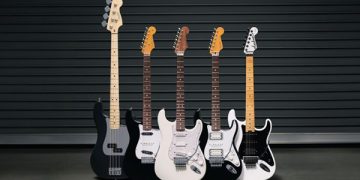
When MIDI – Musical Instrument Digital Interface – first came on the scene in 1983, it ushered in a revolution that essentially merged the ideas of musical instruments (certain ones, anyway) and recording the music those instruments made.
By automating playback of keyboard parts – synthesizers were the first instruments to integrate the protocol commercially – they were basically becoming extra tracks in the recording process, which at the time was mostly on tape and in a never-ending search for more tracks. Via MIDI, developed by synth maker Sequential Circuits, the synthesizer became a sequencer, and more importantly one that could communicate with other MIDI devices. MIDI became the communication standard for an entire range of electronic instruments, such as other types of keyboards and drum machines, which then branched out – with varying degrees of success – to acoustical instruments like drums and wind instruments. When the mating of MIDI and instrument didn’t work out just right, new hybrids developed, like Roland’s Aerophone series. The mating of MIDI and guitars created an entirely new category, with pickups and synth outputs that controlled parameters for itself and other instruments.
MIDI brought new creative possibilities for musicians and recordists alike, but it also brought about new opportunities for MI retail, which at the time was just getting its toes wet with the idea of incorporating pro audio into stores. Early pro audio products were still mainly direct descendants of larger all-pro iterations, with TASCAM and Fostex open-reel 4- and 8-track decks requiring more expertise than most musicians (or salespeople) had yet acquired themselves. But once MIDI came along, it created a new kind of bridge between instrument and technology, between musician and technologist, and most importantly between customer and retailer. The pro audio department in every MI store can trace its beginnings back to MIDI one way or another.
A Robust Protocol
What makes MIDI all the more remarkable is that throughout MIDI’s 37 years on the planet, it’s barely changed. We’ve essentially been using the same MIDI 1.0 that was in use during the Reagan Administration.
Earlier this year, that changed, with the announcement of the MIDI 2.0 standard, when the MIDI Manufacturers Association voted at its annual meeting on the last day of NAMM to adopt MIDI 2.0 as an official spec. Roland, unsurprisingly, was onboard early, announcing the A-88MKII, its first MIDI 2.0-compatible controller. Also at the show, Ableton, Google, Roland, Steinberg, Yamaha and Native Instruments gathered for a MIDI 2.0 Plug Fest.
Also not surprisingly, MIDI 2.0 is more evolution than revolution, building on MIDI’s remarkably robust first iteration. But Darwin would be proud. For instance, velocity increases from 7 bit to 16 bit, so there’s much better resolution. There is also far more granular communication between devices: a feature called Property Exchange lets one device ask another what parameters, such as controller mappings, synthesis parameters, and information about presets. PI’s bi-directionality is a subset of MIDI CI: Capability Inquiry, another new layer that is the basis for MIDI 2.0’s backwards compatibility with original MIDI signals. That means that the entire MIDI ecosystem built up by your customers will be compatible with the new generation of MIDI.
What It Means
That certainly won’t be a hindrance to new sales, though. MIDI 2.0 offers an incremental but substantial retail opportunity, because most of your customer base is already “MIDI-fied” to some extent. MIDI 2.0’s higher resolution and data-transfer speed could make it more applicable to a wider array of instruments – even if guitars and MIDI still have a somewhat fraught relationship more and more guitar amps include MIDI ports. And MIDI’s simplicity and ubiquity make it a great way to entice non-musicians into the store to try the growing array of music-creation platforms that don’t require actual chops.
MIDI has been the lingua franca of music technology for 37 years and will likely do the same for another three or four decades, outliving a number of proprietary formats and doing it virtually for free. That’s a track record that rivals the internet itself for longevity and accessibility. Leverage it.



























Looking Back on 2025: A Year of Controlled Chaos (Emphasis on “Controlled”)